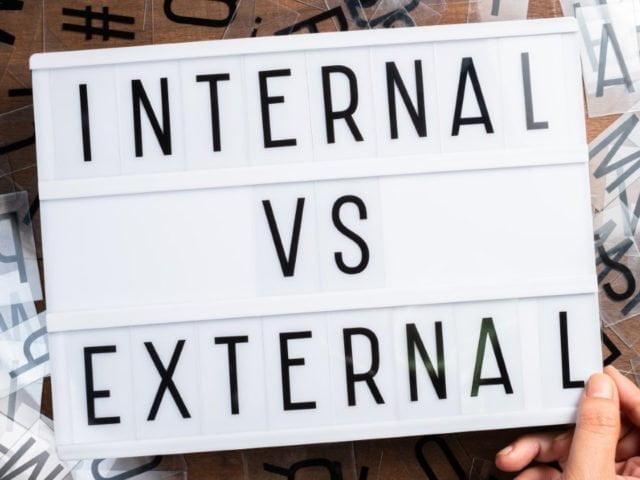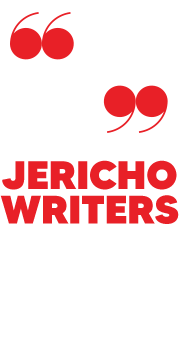You can’t have a story without conflict. But what types of conflict should your characters be dealing with? Will it be the bad guys that get between them and their end goal – or will they be the ones standing in their own way?
This internal vs. external conflict debate may sound unnecessary, and some writers simply choose to ignore it, however injecting various types of conflict in your story can be incredibly useful and makes for a deeper (and more tension-filled) story.
There’s a general misconception that a literary fiction novel can’t have external conflict and a fast-paced thriller can’t have internal conflict – that commercial work is all about action, and ‘deeper’ books are more character-driven. That is simply not true.
Before we delve into this discussion, let’s establish what constitutes internal and external conflict – or indeed, conflict itself.
What Is Conflict?
Conflict is the stuff of drama. It’s the main reason people read books. Nobody is interested in a protagonist that’s like a cork bobbing aimlessly in the water. No. Readers want to root for a protagonist that has some sort of aim in life, stakes that are high and difficult to achieve. To be more specific, a book character needs motivation and the drive to achieve something. The obstacles that arise to prevent that from happening are conflict and they only make us root for the protagonist harder.
There’s a reason why plot-driven series like The Hunger Games and Divergent are so popular. They provide us with solid main characters who are thrust into an inhospitable environment and are asked to survive through them. With plenty of obstacles thrown in their way (be it people trying to kill them, or trauma from their past preventing them from moving on), it makes for popcorn-worthy entertainment. For the same reason, film franchises like Jurassic World, Star Wars and The Lord of the Rings have enduring appeal.
Conflict is what makes a story world compelling and a book ‘unputdownable’. If a conflict is weak then so is the story. The more complex and hard to resolve the issue is, the better the story. The best conflicts are an amalgamation of internal and external conflicts.
So what’s the difference between internal and external conflict?
Internal Conflict
In simple terms, internal conflict pertains to a character’s fight with the self.
This internal struggle tells us a great deal about the kind of person they are. In the film The Woman in the Window, the main character, Anna Fox, suffers from agoraphobia which makes it near impossible for her to venture out of her house. That is internal conflict. It’s this which drives the story forward. Everything that happens in the film basically revolves around Anna’s agoraphobia.
It’s incorrect to say internal conflict only exists in literary fiction. Sure, it can help in exploring the various nuances of a character, but it can also be vital in pushing the story forward. The Woman in the Window is a psychological thriller that thrives on the main character’s internal conflict. Similarly, in Anna Karenina, we have an example of internal conflict in yet another character called Anna. Unhappy in her marriage, she falls in love with a man she can’t have. Her internal struggle is part of the novel’s enduring appeal.
External Conflict
External conflicts arise when things happen that are out of the character’s control and how they affect their life and prevent them from achieving whatever they want.
External conflict is plot-driven and thus is used to great effect in thrillers and action novels. However, that isn’t to say that external conflict has no use in character-driven novels. In Anna Karenina, her society is one of the reasons Anna can’t be with the man she loves. This is a great external conflict example that appears to be a lot more internal.
In the Jurassic World franchise, the conflict doesn’t only arise between the main characters, but mostly due to rampaging dinosaurs being an integral part of the plot. The franchise shows us how, despite every precaution being taken, life itself is difficult to control.
Turning to YA literature, The Hunger Games offers an excellent example of external conflict. Survival is in jeopardy when Katniss Everdeen takes her sister’s place for the games that are held on the order of the Capital. Whatever action she takes against the external forces she’s forced to deal with determine her survival.
The Difference Between Internal And External Conflict
Internal vs external conflicts can be more nuanced than this, but here’s a handy reference to distinguish between the two…
Internal: Psychological, emotional, and the past: fears, mental health, trauma, social conditioning and self-doubt.
External: People/animals/monsters who are out to get your character, an inhospitable landscape, and events out of their control.

Adding Conflict To Your Writing
There’s no better way to move a story forward than to create conflict between characters, their environment, or their internal angst. Without anything to overcome there’s no hero.
Conflict can take many forms, but it can mostly be categorised into two camps: internal and external. A novel that possesses both forms of literary conflict affords readers a well-rounded view of not only the characters but also of the story world and overall theme.
There are plenty of examples of novels that have both. Some that come to mind are: The House at Riverton by Kate Morton, Fates and Furies by Lauren Groff, The Alias Grace by Margaret Atwood and The Corset by Laura Purcell.
Remember, conflict isn’t only about fistfights and weapons causing widespread destruction. Conflict can be as simple as a person applying for a job and the insecurity they might feel from the other participants.
Let’s take a look at how we can add conflict to our work in more subtle ways.
Dialogue
Arguments between characters, not to mention those powerful one-liners, are what drive conflict. Dialogue is often considered one of the best devices for introducing immediate conflict. By applying the old adage ‘Show Don’t Tell’, instead of telling us a character is mean, it’s better to show them being unkind through mannerisms, action and dialogue.
This leads us on to…
Creating Characters With Opposing Views
Novels are generally categorised as follows:
- Action-based (external conflict)
- Reflective (internal conflict)
The action-based novel is driven by events happening in the plot and how the characters respond to them in order to move forward and fulfil whatever purpose they may have. The reflective novel, on the other hand, takes a more languid pace with plenty of characterization. Both of these can be enhanced by introducing characters with opposing views.
Pride and Prejudice, for instance, is an excellent example of a reflective novel where Elizabeth Bennett is torn about her feelings for Mr Darcy throughout the novel. She seems to love and hate him, but ultimately love trumps all. The same goes for North and South by Elizabeth Gaskell where the main characters engage in a dance of love and hate. That is an example of internal conflict and opposing characters.
Subplots
In addition to dialogue and characterisation, subplots are also a great way of adding conflict. Subplots allow minor characters to have storylines of their own, and since a subplot always complements the main plot and never competes with it, we get to understand a bit more about the main characters. Think of ways a subplot and the main plot meet, and how they can create conflict for one another.
Flashbacks
Flashbacks are also a useful device and are useful in establishing the character as three-dimensional, illustrating why the character is struggling with internal conflict. For instance, if a character has faced trauma in the past, the flashback may explain their behaviour in certain situations in the present.
Conclusion
As we’ve demonstrated, conflict in storytelling is a complex subject, but not something that should overwhelm us. On the contrary, conflict is our friend as it can help us write fast-paced scenes and it may be the answer to our plot holes or writing slumps.
Writing conflict doesn’t have to be hard. In fact, whenever the pace of the novel is lagging, conflict is the one thing that will come to your rescue and elevate your novel back to the pace it had in the first place.
So have fun building your worlds and creating characters your readers will root for – then put them through hell!
Jericho Writers is a global membership group for writers, providing everything you need to get published. Keep up with our news, membership offers, and updates by signing up to our newsletter. For more writing articles, take a look at our blog page.











